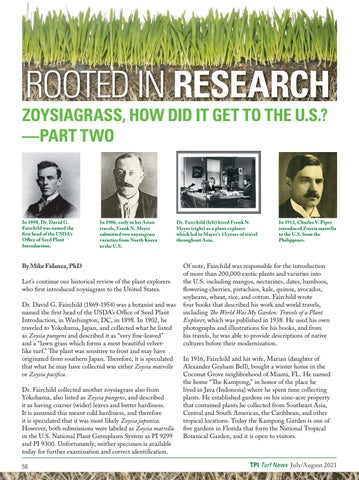ROOTED IN RESEARCH
ZOYSIAGRASS, HOW DID IT GET TO THE U.S.? —PART TWO
In 1898, Dr. David G. Fairchild was named the first head of the USDA’s Office of Seed Plant Introduction.
In 1906, early in his Asian travels, Frank N. Meyer submitted two zoysiagrass varieties from North Korea to the U.S.
By Mike Fidanza, PhD Let’s continue our historical review of the plant explorers who first introduced zoysiagrass to the United States. Dr. David G. Fairchild (1869-1954) was a botanist and was named the first head of the USDA’s Office of Seed Plant Introduction, in Washington, DC, in 1898. In 1902, he traveled to Yokohama, Japan, and collected what he listed as Zoysia pungens and described it as “very fine-leaved” and a “lawn grass which forms a most beautiful velvetlike turf.” The plant was sensitive to frost and may have originated from southern Japan. Therefore, it is speculated that what he may have collected was either Zoysia matrella or Zoysia pacifica. Dr. Fairchild collected another zoysiagrass also from Yokohama, also listed as Zoysia pungens, and described it as having coarser (wider) leaves and better hardiness. It is assumed this meant cold hardiness, and therefore it is speculated that it was most likely Zoysia japonica. However, both submissions were labeled as Zoysia matrella in the U.S. National Plant Germplasm System as PI 9299 and PI 9300. Unfortunately, neither specimen is available today for further examination and correct identification. 58
Dr. Fairchild (left) hired Frank N. Meyer (right) as a plant explorer which led to Mayer’s 13 years of travel throughout Asia.
In 1912, Charles V. Piper introduced Zoysia matrella to the U.S. from the Philippines.
Of note, Fairchild was responsible for the introduction of more than 200,000 exotic plants and varieties into the U.S. including mangos, nectarines, dates, bamboos, flowering cherries, pistachios, kale, quinoa, avocados, soybeans, wheat, rice, and cotton. Fairchild wrote four books that described his work and world travels, including The World Was My Garden: Travels of a Plant Explorer, which was published in 1938. He used his own photographs and illustrations for his books, and from his travels, he was able to provide descriptions of native cultures before their modernization. In 1916, Fairchild and his wife, Marian (daughter of Alexander Graham Bell), bought a winter home in the Coconut Grove neighborhood of Miami, FL. He named the home “The Kampong,” in honor of the place he lived in Java (Indonesia) where he spent time collecting plants. He established gardens on his nine-acre property that contained plants he collected from Southeast Asia, Central and South Americas, the Caribbean, and other tropical locations. Today the Kampong Garden is one of five gardens in Florida that form the National Tropical Botanical Garden, and it is open to visitors.
TPI Turf News July/August 2021










